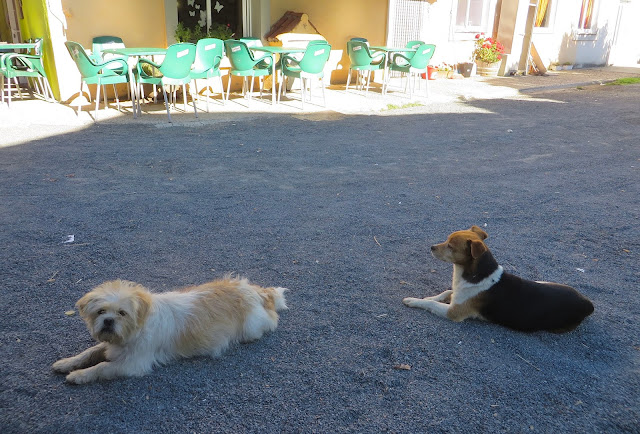On the last day of the Primitivo route I walked from As Seixas to Melide, where the path joins Camino Frances. Melide can be a crowded pilgrim stop, and I wanted to arrive by noon when the municipal albergue opened. Julia and Kasia were thinking of making reservations at a private albergue and got a later start than I did. We made plans to possibly meet for dinner at 7:00, but later I only saw Julia as Kasia had decided to walk on from Melide.
The moon could still be seen on the way out of As Seixas.
Early morning is my favorite time on the Road -- everything feels fresh and the soft light illuminates trees.
Just me and my shadow for most of the walk.
At a later morning breakfast stop in Vilamor, the bar owner's dogs came over to search for any crumbs. By then I was really hungry & ordered a queso bocadillo & Kas limon. My order came with a dish of olives.
A lawn owl
A flower farm on the Road near Melide
Hello Kitty
Flags representing Galicia, Spain, & the E.U. blue were displayed at Melide's town hall in the main square Praza do Convento. Melide's history includes prehistoric settlements in the area and a connection to the Camino since the town's foundation in the 10th c.
Besides being a major pilgrim portal, Melide is also known for pulpo, or octopus, and sweet treats (pastries & cakes). There's a celebration in May called the Melindre and Traditional Pastry festival to honor these sweet treats.
Besides being a major pilgrim portal, Melide is also known for pulpo, or octopus, and sweet treats (pastries & cakes). There's a celebration in May called the Melindre and Traditional Pastry festival to honor these sweet treats.
The Sancti Spiritus church in the plaza dates back to the 14th c. and belonged to the Third Order of St. Francis, a secular order formed by the saint during the 13th c. In the 15th c. Sancti Spiritus was rebuilt using stones from the town's wall destroyed in a revolt against the ruling power.
St. Francis' image can be seen in a niche above the main entrance; he's identified by the brown robe and cord with 3 knots that represent the vows of poverty, chastity, & obedience. Across the square is a former pilgrim's refuge that's now a museum and tourist information office.
St. Francis' image can be seen in a niche above the main entrance; he's identified by the brown robe and cord with 3 knots that represent the vows of poverty, chastity, & obedience. Across the square is a former pilgrim's refuge that's now a museum and tourist information office.
There were already walkers waiting in line when I arrived to the municipal albergue. Spanish amigas from Valencia sat next to me on porch benches -- they rubbed each other's tired shoulders and showed great 'pilgrim spirit'!
An horreo next door could be seen through the window near my bed.
Pilgrim cyclists parked their bikes outside while checking in the albergue. Although I rarely saw riders on the Primitivo, they're fairly common on the Frances.
On a Sunday afternoon Melide's streets were quiet with many shops and mercados closed except for restaurants/bars around albergues and hotels. The surge of Camino walkers in recent years has contributed to the local economy, harkening back to the Middle Ages when the town's hospitals and businesses served pilgrims.


















No comments:
Post a Comment